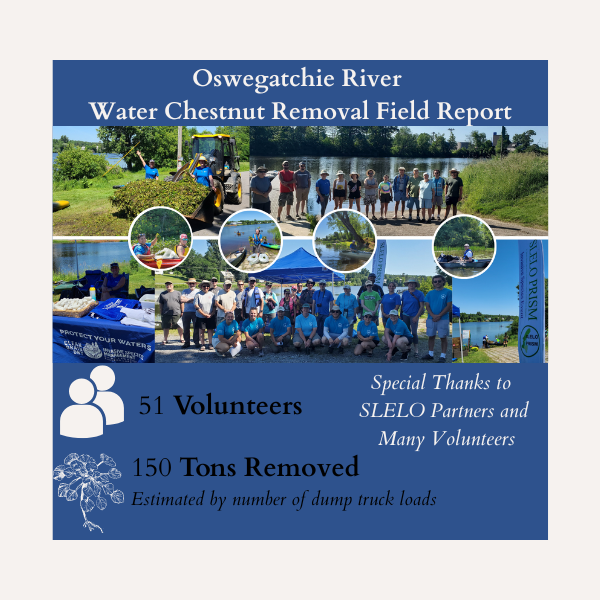Background
Water chestnut (Trapa natans) is an aquatic invasive plant that forms large mats that shade out native aquatic vegetation and has the ability to completely dominate surface waters. It reduces oxygen levels for fish and encourages sedimentation by restricting silt movement. The hard, pointy seeds of water chestnut can puncture vehicle tires or injure feet if stepped on.
There is an infestation of water chestnuts on the Oswegatchie River that spans roughly 130 acres (calculated using iMapInvasives Area Tool) above the dam in the Village of Heuvelton; in addition to sparse populations of water chestnut present throughout the river between the dam and Eel Weir State Park (see map below). If not managed, this infestation can grow and easily spread to connecting waterbodies, like Black Lake.

Survey & Management
- In 2020, SLELO PRISM’s Early Detection team surveyed the river upstream from the Village of Heuvelton to investigate an iMapInvasives report submitted at the end of 2019.
- In 2021 a survey between the Village of Heuvelton and Eel Weir State Park was conducted by SLELO PRISM, NYS OPRHP, the Black Lake Association, and volunteers. Sparse
- populations were found, and 250 pounds of water chestnut removed. Data was recorded to iMapInvasives.
- In February of 2022 SLELO PRISM coordinated a stakeholder meeting to organize a removal effort to include the larger infestation above the dam in addition to efforts below the dam.
- In June of 2022 mechanical harvesters provided by the Black Lake Association, the Comprehensive Weed Control of Northern New York, and Weedo began to remove waterchestnut above the dam. On June 25th, 2022, a large, organized removal effort consisting of mechanical and manual removals took place above the dam. NYS OPRHP led a manual removal effort below the dam to the Eel Weir State Park. Data was recorded to iMapInvasives.
Metrics
The numbers below reflect the water chestnut removal effort held on June 25th, 2022.

Management Options
Considering the large size (+- 130 acres) and overall density of the water chestnut population on the Oswegatchie River a suppression management approach is suggested. This approach will aim to reduce the population over time by reducing biomass and by reducing the viable seed bank. Management options may include such things as:
- Mechanical harvesting
- Volunteer hand pulls
- Herbicide treatments
- Benthic matting
- Biological control (not available yet)
Each option has pros and cons and varies in logistics, costs, and permit requirements. In this circumstance and given the large size of this infestation, we should note that comparable projects have taken place using mechanical harvesters, herbicides, and combinations of each along sections of the Oswego River coordinated through the local Soil & Water Conservation District. This option may be an effective consideration for the Oswegatchie River.
Next Steps
The Black Lake Association has selected mechanical weed harvesters and volunteer hand-pulls as their preferred control method. Support from local and regional stakeholders along with waterfront property owners and community members would greatly enhance the success of this approach. Hosting an annual removal effort could also help to raise awareness of the importance of taking action to prevent the introduction of aquatic invasive species.
The Black Lake Association is leading an effort to secure funding and support for future management of this infestation. Through their efforts, it is hoped that new grants could be available to address the water chestnut population and to serve as a fund for similar future situations.
The accomplishments of this control effort so far are a positive example of the conservation impact that can be made by collaborating among various stakeholders.
Acknowledgments
This initial removal effort was possible through the coordinated efforts of multiple organizations, partners, and volunteers, including but not limited to:
Black Lake Association, SLELO PRISM, Brookfield Renewable, NYS Office of Parks Recreation and Historic Preservation, NYSDEC, Save The River, Thousand Island Land Trust, the Cornell Cooperative Extension of St. Lawrence County, Indian River Lakes Conservancy, the Village of Heuvelton Fire Department, the City of Ogdensburg Fire & Rescue, the town of Morristown, the Chippewa Bay Fish and Game Club, Chippewa Yacht Club, Black Lake Fish & Game Association, St. Lawrence Waterfowlers, St. Lawrence Valley Sportsman Club, St. Lawrence Sportsmen’s Federation, St. Lawrence Federal Credit Union, Comprehensive Weed Control of Northern New York, Weedo, and many volunteers.


